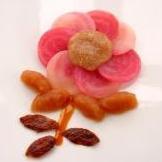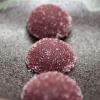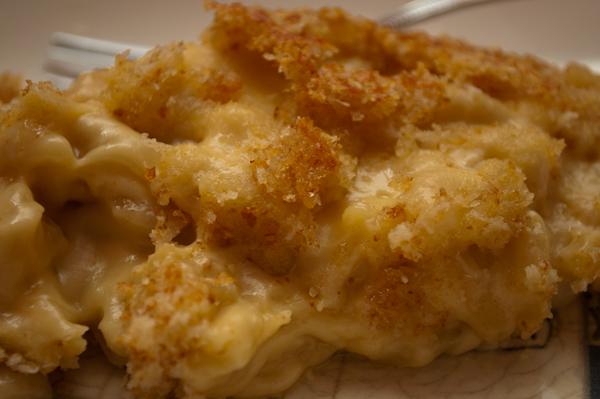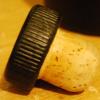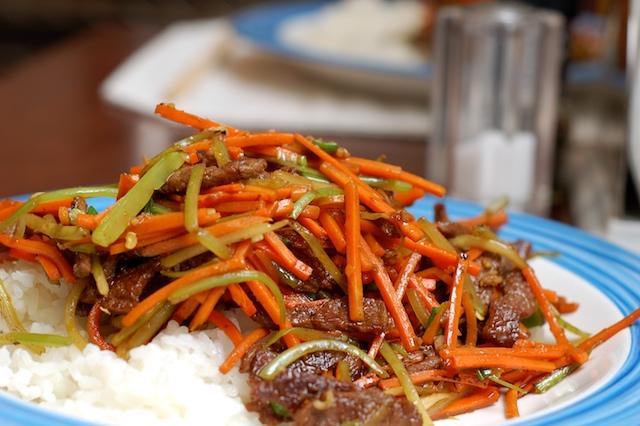Search the Community
Showing results for tags 'Cookbook'.
-
I would be interested to buy some Peruvian cookbooks, like the series named Nuestros Grandes Chef published by El Comercio, or some books published by the University of San Martin de Porres. I wrote to both editors, but never received any answer. Is there any forum user living in Peru and willing to help me? Of course I would pay something for the help. Thanks in advance. Teo
-
Even with all the attention being lavished on Modernist Cuisine, I find it hard to believe no one has been cooking from Ideas in Food! The first preparation I made from it was red wine vinegar; before reading the book, I'd been reluctant to use cider vinegar as the starter (even though it's the easiest vinegar to find with a live mother), but they convinced me to stop being such a purist about it. I've been regularly feeding my red wine vinegar over the past few weeks, it's thriving, and I love the flavour. I've used it in everything from vinaigrette to Sauerbraten. Last night I made the macaroni and cheese recipe. The version in Modernist Cuisine calls for sodium citrate and carrageenan; the version in Ideas in Food just calls for evaporated milk, which already has disodium phosphate and carrageenan in it. I think this is a really elegant solution if you don't want to spring for the specialty chemicals. Better still, the recipe worked like a charm, and was fast and delicious. I'm looking forward to playing with different kinds of cheese, but I think it's safe to say I'll be keeping a can of evaporated milk handy at all times from now on. Edit: Society-friendly Amazon link.
-
[Moderator note: The original "Modernist Cuisine" by Myhrvold, Young & Bilet topic became too large for our servers to handle efficiently, so we've divided it up; the preceding part of this discussion is here: "Modernist Cuisine" by Myhrvold, Young & Bilet (Part 1)] I wouldn't pay much attention to the Amazon estimated shipping dates. It is unclear to me that they have any real basis. All of the books in the first printing will ship from China to in the US, Canada or Europe in the next 3 weeks, and a few thousand are currently somewhere in the Pacific Ocean. So far about 2/3 of the first printing has been pre-ordered. So everybody currently on order ought to get books from these shipments. A second printing is being ordered. You'd think that traveling thousands of miles by boat would be the majority of their journey. But that isn't really the case. So far they have had several snafus in getting the books out. Some distributors shipped books to the wrong distribution center. Some decided to ship books by train from Seattle to various places in the middle of the country. Some shipped to one distribution center, then decided that the books were too heavy for the equipment at that center, so they proceeded to ship them by truck to another distribution center. One distributor seems to have lost track of 150 books - hopefully this is just a computer error. It is frustrating, and I am trying to get it all fixed for future shipments. As as result, the first batch of books has been in the US since early February but took another 3 weeks or so to reach customers. I'm sorry about that, but there is not much I can do. In principle the remainder of the books ought to reach customers in March, but I suspect that it will take until some point in April due to various silly delays in the book distribution system.
-
A few years ago, for the most part, I stopped buying tomatoes "out of season." In other words, I quit buying tomatoes if they weren't grown locally during Mother Nature's natural growth cycle. While I am sure that the Producer's and Marketing Teams will tell us that tomatoes harvested in January are at the "peak of their flavor," is a tomato picked weeks in advance in preparation for a 3,000 mile journey really compare to the flavor of a local tomato in season? Sure, I tried the "tomatoes on the vine," the "salad" tomatoes, the "hydroponic" tomatoes and the "organic" tomatoes and while some of them had passable flavor, they never compared to the local tomatoes I buy in August. (I may buy a Roma tomato or two in December to slice and add to salad, but that's it). Right now we still have the remnants of last week's snow and a new dusting is expected tonight. Fresh, local tomatoes won't show up in our markets for at least 4 months around the end of June and the crop will last through mid-September. I gladly cook with quality canned tomatoes during the dormant months. (Just last week I made a delicious braised veal dish with canned San Marzano tomatoes). It begs the question; have you ever found a tomato "out of season" that compares to a fresh, local tomato "in season?"
-
Folks, we appear to be approaching a momentous date in publishing history. Of cookbooks. At least that's what I've heard. Yes, the greatest cookbook series ever is going to be in a bunch of food crazy people's hands very shortly. Actually, it appears to be in some people's hands already . Now, trust me, I'm as crazy as the rest of 'em...and anxiously awaiting my copy from Amazon (and don't tell my wife, please). But, and here's the big but, there have been some cookbook series released in the past that I think are pretty damn good. Mastering the Art of French Cooking Volumes 1 & 2 were no slouches, and were pretty groundbreaking, if I recall correctly. Jacques Pepin's The Art of Cooking Volumes 1 & 2 have a place on my shelf. As does Time Life's 23-volume Foods of the World set. However, for my money, the greatest cookbook series ever published (up until next month, that is) is still Time Life's The Good Cook series. A 28-volume series whose chief consultant was the great Richard Olney, the scope and breadth of the work is simply amazing, in my opinion. Great photos, great writing and great educational technique are all there. Now, that's just my opinion, and I'm wondering what everyone else thinks about this.
-
Q&A with the Modernist Cuisine Team The Society for Culinary Arts and Letters is thrilled to be able to offer this Q&A with the team behind Modernist Cuisine: The Art & Science of Cooking. This ground-breaking multivolume work has spawned two discussion topics, one focusing on the book and one devoted to cooking with the book. In this topic, we will have the unprecedented opportunity to explore the book's development, design, and production with the team that made it happen. The book authors -- Nathan Myhrvold (Society member nathanm), Chris Young, and Maxime Bilet -- worked with editor-in-chief Wayt Gibbs to answer several questions we posed. The team also shares for the first time a multipage arc of content that traverses several volumes across a crucial content area: how understanding the weirdness of water can benefit your understanding of cooking. (Please click on the thumbnails of each page below to see a larger image.) What follows provides an opportunity to get to know Modernist Cuisine that much better, a book that many are hailing as one of the most important publications in the history of cooking. In addition to the excerpts and initial Q&As, Wayt Gibbs will respond on behalf of the MC team to your questions. We hope that you enjoy this opportunity to take a glimpse at this remarkable book.
-
I picked up this book recently and had my first chance to cook with it this evening. I was drawn to it because many of the recipes within can be made with simple, fresh ingredients that I can easily locate. And couscous, which I can get at the Carrefour. The first thing I did was set some preserved lemons going: This is the simple, four-day method that calls for lemons boiled in brine for about a half hour; then covered in oil. Then, the chicken roasted with honey, cinnamon, and ginger - Roast Chicken with Couscous, Raisin, and Almond Stuffing, p. 92. The top got too close to my element, but it tasted exceptional. The honey sauce that drips off the chicken is just the thing for drenching the couscous with to serve. The only ingredient I couldn't get was the orange-flower water, which I simply left out. On the side, I made the Mashed Eggplant and Tomato Salad, p. 42 because I'll eat eggplant served up pretty much any way I can. Really good. I plan on making this throughout the summer - with bread and cheese it would be enough for dinner on a hot night. I only wish I had better quality olives. There was plenty for leftovers for lunch, too. Once the lemons are done, I've got the chicken, olive, and preserved lemon tagine bookmarked to try. If anyone else has got this book, I'd be interested in seeing what you've tried or hearing what's good.
-
I've been looking through a lot of old cookbooks and culinary magazines on Google books and noticed this. Apparently, if you want to avoid getting sick in the winter, you should eat lots of fat. I guess it was most shocking to me because in todays overly cautious world, virtually nobody would suggest to increase you fat intake for nearly any reason. http://books.google.com/books?id=E1kBAAAAYAAJ&pg=PA327&img=1&zoom=3&hl=en&sig=ACfU3U01NhL6dSdPr4csM9bYjhWd8FDBOw&ci=29%2C156%2C914%2C1248&edge=0 Has anybody else noticed similar items in their old books?
-
Today's email from Leite's Culinaria was headed with a note about "The Fat Lady" and clicking on Fat Lady took me to Jennifer's Blog. Heading it is the post about her new cookbook coming out in September. For those who do love "The Rest of the Animal" this looks to be a great addition to a cook's library. I discovered that I have other books by this author. I've long been a proponent of "natural" fats (as have many others in this forum) and I'm surprised I had forgotten the "Fat" cookbook, which I purchased some two years ago and managed to shuffle aside with a stack of others books acquired about the same time. I also have "Bones" and found it after reading about roasted marrow bones in another thread on this forum.
-
eG Forums topic on Modernist Cuisine by Nathan Myhrvold & Chris Young. Society-friendly link to their multi-volume book on Amazon. As the above topic indicates, Society members are pretty excited about the arrival of the multi-volume MC package. Thanks to the generosity of the MC team, a few Society members have been granted access for two weeks to an online version of the book. (Here's my initial reaction.) Our exposure to this remarkable project is prompting one major reaction: what should we cook first?!? Thus this topic, a place where we can all discuss what we'll do and how we'll do it, then compare notes about what did (and didn't) happen. Along the way, we can also share kludges, sources, photos, and the like. Indeed, cooking many of the things in MC may require a bit more preparation than other cookbooks, whether it be sourcing some sodium hexametaphosphate or getting your hands on a chamber vacuum sealer. But that's not to say that every dish need be a hydrocolloid-n-liquid-nitrogen showpiece taking the better part of a week. Volume 6, the Kitchen Manual, is filled with recipes for everything from house cocktail bitters to potato purée, from SV stock to hamburger buns. I, for one, plan to start with some basics! There's some content already available online at the Modernist Cuisine website, and those of us with access to the online copy may get started a bit early to whet your appetite. Of course, next month, we'll all have copies to cook from. Because you bought it, right?
-
Has anyone found any old public domain cookbooks or books on food in Google books? I've done a little searching but mostly end up with books using food as a metaphor.
-
Hello all- Is anyone aware of an online nutrition calculator that home cooks can use? I would like to enter all of my ingredients and get the nutrition information for the dish I am cooking. More importantly, I would like to be able to play with the amounts of ingredients in order to serve a healthier dish. For example, cutting the butter in 1/2 for sauteing onions may make a minimal change in taste, but a substantial change in calories. It could mean the difference between someone being able to have a serving of something they really miss or not. Thanks in advance for any suggestions.
-
Reports are that Michael Ruhlman and Brian Polcyn have a second charcuterie book on the way. Their first book was a transforming one for many Society members, including yours truly. We have two massive topics devoted to discussions about the book, the first one here (with the index Chris Hennes built for it here) and the second one here. Amazon doesn't list the book on its Ruhlman page yet. What have people heard? ETA: "Salumi" product page.
-
I'm becoming more and more interested in cooking with grains. Right now I use chia, millet, buckwheat and quinoa but am interested in trying others. Does anyone know of a comprehensive book that goes into detail about the different grains available and also has some recipes to give me some idea as to how to cook them? Thank you.
-
So, I've got a boatload of cookbooks. Some I cook from, some I cook with, some I read, some I don't. What cookbooks do you have that you won't be using as recipe guides, but that you like to read and/or look at the pictures? I'll start with a newer addition to my collection: NOMA Time and Place in Nordic Cuisine. It's a stunning book, but I think I might have trouble finding many of the ingredients being used.
-
I'd like a copy of Apicius. I'd like an English translation and I'd prefer--really prefer--it to have no substitutes for ingredients. Or, if it does include substitutes, to also mention what the original ingredient was. I've looked at a couple of online versions and found it doesn't tell you what the original item was. What's the best and most reliable hardcopy translation?
-
I saw several articles back in the summer that Phan was finally writing a Slanted Door cookbook. Anybody know when this will be released? I've Googled to no avail.
-
I received "American Pie" along with a new peel and stone for Christmas. I have just a regular GE oven so 500 degrees is as hot as I can go and I have the Emile Henry pizza stone. I was wondering if anyone else had this book and which of the doughs fared the best in a home oven.
-
Why is there no talk about this book? It seems to be completely overlooked, which surprises me, as Platter of Figs is one of my all-time favorite cookbooks. What's the deal?
-
I have to come up with a savory recipe using champagne (or other sparkling wines). Any ideas? Is it generally considered a bad idea to cook with champagne? Doesn't the characteristic quality of champagne (the festive fizz) disappear when you cook with it? For the recipe, I would prefer it wasn't one of those ultra fancy ones (lobster with champagne/caviar sauce, or something like that): I think it would be much more interesting to use the champagne in a simpler and less expensive dish. All thoughts much appreciated.
-
I just got a copy of Grace Young's "Stir-Frying to the Sky's Edge"—I enjoyed cooking from "Breath of a Wok" and wanted to continue on that path. Does anyone else have this book? Have you cooked anything from it? Here was dinner tonight: Spicy Dry-Fried Beef (p. 70) I undercooked the beef just a bit due to a waning propane supply (I use an outdoor propane-powered wok burner), but there's nothing to complain about here. It's a relatively mild dish that lets the flavors of the ingredients (and the wok) speak. Overall I liked it, at will probably make it again (hopefully with a full tank of gas).
-
I'm surprised no-one has started a thread on this as yet, so here goes. There is a very new web site (so new it's still in Beta) that you can enter your cookbooks into to create an on-line bookshelf. This is the slow and tedious part of the process (particularly if you have as many cookbooks as I do). What comes next is the neat part. A lot of books have been indexed, with all the recipes and their respective ingredients. Want to search through your books for a recipe using lobster and vanilla? Enter the ingredients into the advanced search engine and up pops all of the recipes from indexed books in your own library that contain these two ingredients. They also give the rest of the ingredients and allow you to add these to your shopping list, which is categorised by type of produce so you can order your shopping around the store. I'm not sure how many books have been indexed so far and not all of my books were on there but I do know that from today I have indexed 176 cookbooks and can search through 12,022 recipes. No more simply going to old standby cookbooks. I'm sure I'll get more use out of my library as a cooking resource using this website. The web site is called eat your books. At present the site is in beta but is accepting subscriptions (current price is $25 per annum or $50 as a limited offer for lifetime membership). It's an idea that I wish I'd thought of but am really pleased to be able to use.
-
I just received a copy of "The Cook's Book - Concise Edition" edited by Jill Norman, and now I'm curious, what's the difference to the full edition? Supposedly it has 648 pages compared to 496 in this edition, and it appears to be much larger in size if the info on us.dk.com is correct. Other than that I can't find any info what the difference might be. It's a neat book with lots of photos about techniques etc, and lots of recipes. As with any DK book production values are high. If the contents are the same, I'm happy with the smaller version, but I'd really like to know what I might be missing on those 150 or so pages. If it's just filler, I don't care. If it's some fantastic recipes, I do care.... Anybody here know both editions? Google was so far of no help. Lots of the full edition are to be had used as well, I'd be happy giving this one as a gift and ordering the full edition, if it's worth it. Thanks! Oliver
-
In this topic on the cookbooks that shaped us, a few series of cookbooks have been mentioned: Sunset books and the Time-Life Foods of the Worlds spring to mind. Other than those, I know that Williams-Sonoma has a selection of single-subject cookbooks, and of course there's the "Beautiful" series, but I'm not very familiar with any others. I'm sure they're out there, although it seems to me that series aren't as popular as they used to be in cookbook publishing. So maybe the series that are worth checking out are old ones, but maybe I just don't know about the contemporary ones that are available. Are there series that are worth buying today? Which old series are worth tracking down? Is it just a collector's passion, or can one actually cook from these?

